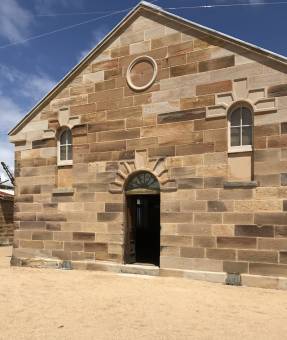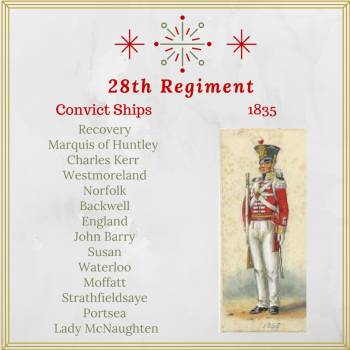Convict Ship Strathfieldsaye (2)
1836
Embarked: 270 men
Voyage: 118 days
Deaths: 1
Surgeon's Journal: yes
Previous vessel: Thomas Harrison arrived 9 June 1836
Next vessel: Moffatt arrived 31 August 1836
Captain Philip Jones
Surgeon Thomas Braidwood Wilson
Prisoners and Passengers of the Strathfieldsaye identified in the Hunter region
The Strathfieldsaye was built at Chepstow in 1829. [3]
The convicts on this voyage were convicted in England Scotland and Wales - Dorset, Berks, Middlesex, Warwick, Essex, Somerset, York, Southampton, Norfolk, Gloucester, Worcester, Northampton, Leicester, Suffolk, Lancaster, Wiltshire, Sussex, Salop, Nottingham, Chester, Oxford, Derby, Devon, Surrey, Bedford, Stafford, London, Bristol, Ayr, Carnarvon, Perth, Dumfries, Aberdeen, Glasgow, Edinburgh. There were also thirteen prisoners who were tried in Jamaica. [1]
Thomas Braidwood Wilson R.N., was appointed Surgeon Superintendent on 20 November 1835. He kept a Medical Journal from 16 December 1835 to 18 June 1836. [2]
Deptford
Thomas Wilson joined the ship at Deptford on the 16th December while he ship was still being fitted out.The ship was delayed and not ready for sea until 27th January 1835. On this day the guard, a detachment of the 28th regiment was embarked at Deptford.
The Guard consisted of Lieutenant Cadell, and Ensign Garling, and 28 rank and file of the 28th regiment.
Passengers included Mr. Thomas Smith, farmer; Miss Cameron, governess; Mary Peacock and Caroline Freeman, Servants; eight soldiers' wives, and thirteen children.
Woolwich
The Strathfieldsaye arrived at Woolwich where seventy prisoners from the Justitia hulk were received and then to Portsmouth where 200 prisoners were embarked. In consequence of heavy weather and contrary winds they did not reach the Downs until 3rd February. At the Downs the ship struck on a sand bank where she remained hard and fast, however fortunately the tide was flowing rapidly and in half an hour the ship was afloat.Portsmouth
On 6th February 130 prisoners were received from the Leviathan Hulk at Portsmouth and 70 from the York. Thomas Wilson remarked in his journal that during all his former voyages he had never seen such miserable looking prisoners.Evidence from a prisoner who had been sent to the Leviathan hulk was later presented in Parliament. This man was first sent from the Old Bailey to Newgate and then removed to the Leviathan hulk at Portsmouth in December 1835...............
He was placed in the lower Deck, No. 6. Cell, where there were from Twelve to Fifteen Convicts; they slept in Hammocks; there was a Wardsman in it, a very steady Man, who had been Five Years in the Ship; he never reported any body whilst he was on board; the Convicts returned from their Work in the Dock Yard between Four and Five o'clock in the Evening, they then took their Hammocks from the Main Deck to their respective Divisions; Lights were permitted 'till Eight o'clock; there was a Lamp with Oil for each Cell found by the Ship, but there was an old Prisoner called the Boatswain's Mate, who sold Candles to the other Convicts; at Eight o'clock the Lights were put out in the Cells and the Doors locked, but from Half past Four until Eight the Convicts of one Cell might go to any other Cell in the Deck; during this Time there was very bad Conversation carried on, cursing and swearing often, with' Histories of former Exploits; never saw any gaming; saw Bibles and Prayer Books in No. 6. Cell, and saw Men occasionally reading them; from New Year's Day last no Provisions were allowed to be received or purchased, except Potatoes and White Bread, the latter could only be had once a Week, but a Prisoner, one of the Washermen, sold Potatoes daily.
Departure
The Strathfieldsaye was detained at Spithead by strong adverse winds until 18th February 1836 when they weighed anchor. They had a favourable passage down the channel and across the Bay of Biscay. They passed to the eastward of Madeira and approached too near to the Coast of Africa when they 'got entangled among the Canary Islands'. They passed to the west of the Cape and Verdi Islands and had a favourable passage across the line.The South-East Trade winds carryied them far to the southward to within sight of Cape Frio and it was therefore deemed prudent to touch at Rio rather than run the chance of being obliged to touch at the Cape of Good Hope. Accordingly on Sunday 3rd April they anchored off the entrance of the harbour. The next day within the harbour they had a narrow escape from collision. The surgeon was greatly vexed at the want of caution or skill in the Master who promised to pay more attention to the surgeon's advice in the future.
They took in a supply of water, fresh beef and vegetables and also six bullocks and left Rio in good health.
The Voyage
Thomas Wilson related his methods of managing the prisoners in his journal:As soon as they were received on board they were divided into messes with 8 men in each and properly arranged in their berths. Cooks and others were selected from the most active among the prisoners. The irons were removed from all the prisoners and they were allowed on deck constantly from 7 am till nearly dark. The decks were dry holystoned and hanging stoves kept burning between decks throughout the day. [2]
Port Jackson
They had a fair average voyage to NSW and arrived on 15th June 1836.Convicts Disembarked
On 24th and 25th June two hundred and sixty nine prisoners were landed in a far better health than when they embarked according to the surgeon. The surgeon remarked that there was not the slightest disturbance during the voyage. The prisoners behaved with becoming decorum and propriety and there was no instance of personal punishment.A service was held at St. James' Church on the morning of 27th June instead of the evening in order that the convicts who arrived in the Strathfieldsaye could be addressed from the pulpit. The Monitor reported......
The salutary practice of addressing prisoners in the Lumber Yard, on their arrival by the Governor in person has been discontinued in the colony since the days of Governor Macquarie, although we understand it has been the practice in Van Diemen's Land. We are not aware to whom we are indebted for the revival of the custom in this new shape, but a sensible address to the prisoners on their first landing must have a beneficial result; though no address from the pulpit will be likely by this class of men, to be so beneficial as one from the Governor in person. [4]
Notes and Links
1). William Law/Low who arrived as a convict on the Strathfieldsaye was sentenced to 15 years transportation at Cockatoo Island in 1845 after he was found guilty of robbing the Crown and Anchor Inn at New Freugh. Convict Barracks at Cockatoo Island
Convict Barracks at Cockatoo Island2). Prisoners and Passengers of the Strathfieldsaye identified in the Hunter region
3). Convict ships bringing detachments of the 28th regiment included the Recovery, Lady McNaughten, Charles Kerr, Westmoreland, Marquis of Huntley, Norfolk, Backwell, England, John Barry, Susan, Waterloo, Moffatt, Strathfieldsaye and Portsea.....

4). Thomas Braidwood Wilson was also employed as surgeon on the convict ships Richmond in 1822 (VDL), Prince Regent in 1824, Mangles in 1826, Governor Ready in 1829, John in 1830 (VDL) and Moffatt in 1834 (VDL).
References
[1] Convict Indents. State Archives NSW; Series: NRS 12189; Item: [X639]; Microfiche: 722[2] Medical Journal of Thomas Braidwood Wilson. Ancestry.com. UK, Royal Navy Medical Journals, 1817-1857 The National Archives. Kew, Richmond, Surrey.
[3] Bateson, Charles Library of Australian History (1983). The convict ships, 1787-1868 (Australian ed). Library of Australian History, Sydney : pp.354-355, 390
[4] Sydney Monitor 27 June 1836
↑
